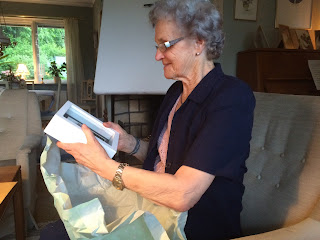John spoke often about his
younger brother, Anders, back in Sweden. He wished for a day when his family
could see the home and farm he had built. I don’t know when communication
stopped between John and his family in Sweden but I do know he never got his
wish. By the time we began looking for family, 100 years after John said
goodbye to them in Sweden, too much time had gone by and the delicate threads
we all know hold our family history together were broken.
Uncle Don (one of my dad's
brothers) and I have looked for relatives in Sweden for years with no luck. I
put everything we knew in my public tree on Ancestry and there it sat for many
years. As I learned how to search Arkivdigital, the
Swedish online database of old records, I added what I found. My tree was
online for years and although it has been instrumental in finding many cousins
on my mom's side, we never made any progress on the Swedish branches.
Meanwhile, in Jönköping, Sweden,
an 86 year-old woman named Gunnel, often wondered what happened to the part of
the family that had gone to America. Her grandfather, Anders Gustaf Johannesson
told of a brother, Johan and a sister, Britta who had emigrated from Sweden to
America in the 1869. She even had, in her home, Britta’s trunk which she had
left behind when she emigrated.
Then, for Christmas 2012,
Gunnel received an iPad as a gift from her children. As she learned how to use
it, she decided she would try to find her family in America through
Ancestry.com.
In April 2013, I received a message on Ancestry.com from a woman in Jönköping saying that she thought we were related. I was very excited but also afraid of being disappointed, if I found out that it wasn't a match. After MUCH checking and matching of our information, I finally allowed myself to believe I was communicating with the granddaughter of my great grandpa's younger brother, Anders. I just about reached hero status for a while among my aunts and uncles and of course my own dad who has since died, just for having put the family tree on ancestry where it was found. |
 |
| Gunnel with the iPad she used to find me! |
It was the first visit to Sweden for Kris and I and we immediately
felt as if we were home. We grew up in a very Swedish-American culture, so
actually being in Sweden validated so much of our lives and childhoods in ways
nothing else could. On our way to Jönköping, we visited the western and
southern cities of Gothenburg, Ängelholm (to meet a Facebook friend) and Malmö.
Then we were on to Jönköping and our family!
 |
| Ninni, Gunnel, and Marianne at our welcome Fika. |
Altogether, we met 14 relatives! Our cousins welcomed us with open
arms and we felt very comfortable in their homes! We stayed with Gunnel
in her home and celebrated Midsommar with them in Gunnel’s son, Anders', home in
Jönköping and again later in Dalarna.
 |
| Christina, Gunnel, Christer and Shari looking at genealogy. |
My Cousin Christina’s husband, Christer, is also a genealogist. He presented me with a large notebook containing his work on the history of the family; complete with color pictures of family groups and the inside of some of the homes!
 |
Kris and Shari celebrating Midsommar’s
Day in Jönköping.
|
Before my trip I did some thinking about the gift I would bring
Gunnel. She sent me many pictures of family homes and I wanted to bring her
something that she would think was special. Then I remembered what my Uncles
and Dad had told me many times. John’s wish for his family to see his Kansas
home had gone unfulfilled.
 |
| Gunnel unwrapping her gift. |
With the help of my kids, I retrieved a piece of wood from the abandoned home John and Ida built on the homestead now hidden from view behind barbed wire, brush and trees. I framed the wood with a photo of the house at its peak about 1915.
That is what I brought to Gunnel.
Anders may not have gotten to see John’s home but his granddaughter now has a piece of it hanging on her family history wall in her home in Sweden.


